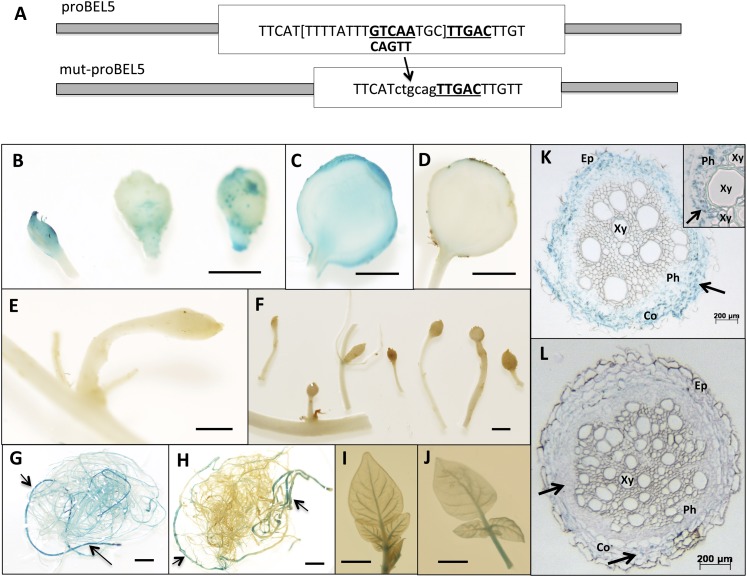Figure 6.
A, Schematic of the modification of the wild-type StBEL5 promoter sequence. To create the mutated StBEL5 promoter used in the transgenic lines reported here, one of the tandem TTGAC cis-elements (underlined and boldface) that make up the binding motif for StBEL5 and its KN1-like partner, POTH1 (Chen et al., 2004), was deleted. To facilitate cloning, this five-base motif plus the TGC linker and eight other bases (all in brackets) were removed and replaced by the ctgcag sequence. The intact wild-type double motif sequence begins 820 nucleotides upstream from the start of the StBEL5 5′ UTR (Chatterjee et al., 2007). The wild-type StBEL5 promoter sequence analyzed here was 2,002 nucleotides in length. B to L, StBEL5 promoter activity in newly formed tubers (B–F), roots (G, H, K, and L), and leaves (I and J) of andigena plants grown under short-day conditions (8 h of light/16 h of dark). Transgenic lines contained constructs of the wild-type StBEL5 promoter (B, C, G, I, and K) or a mutated form lacking one of the tandem TTGAC motifs (D–F, H, J, and L), both driving a GUS marker gene. Arrows in G and H indicate GUS activity in primary roots. GUS activity of the wild-type StBEL5 promoter (K) and the mutated form (L) in transverse sections of primary roots can be observed in phloem cells (inset in K, arrow), in the cortex of lines with the wild-type promoter (K, arrow), and in the cortex of roots from the mutated promoter lines (L, bottom arrow). Very little GUS activity was observed in phloem cells of the mutated promoter lines (L, top arrow). In primary roots, the cortex layer may become compressed in response to the expanding vascular cylinder. Co, Cortex; Ep, epidermis; Ph, phloem; Xy, xylem. These samples are representative of several independent lines. The P-StBEL5 line from Chatterjee et al. (2007) is shown here for the wild-type proBEL5 construct, whereas the mut-proBEL5 line is CI-12-8. For G through L, similar results were obtained from plants grown under long-day conditions. Bars = 5.0 mm (B–F) and 10 mm (G–J).

